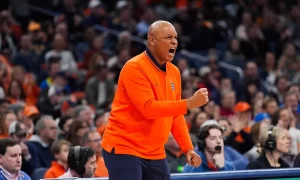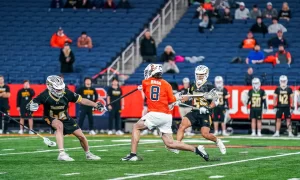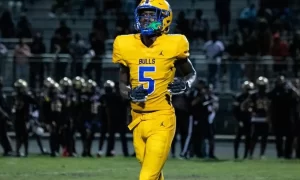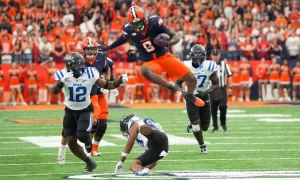The names from recent Syracuse basketball history may never go into the rafters at the Carrier Dome, but it’s only because they left for the NBA too quickly. Since 2010, Syracuse has paraded first-round picks through Central New York like no other time in program history. This is no coincidence.
After Syracuse’s deliriously captivating run of success in the ’80s, the program fell into a period of mediocrity. After its NCAA violations and postseason ineligibility in ’93, Jim Boeheim’s teams were good, but never great. For the next decade SU would only get past the Sweet 16 once, in ’96 on a magical run by John Wallace and co. The ’80s saw NBA talent march through the Dome every year, names like like Pearl Washington, Derrick Coleman, Rony Seikaly, Billy Owens, and Sherman Douglas. But the ten-year stretch from ’93-’02 developed only two first-round NBA picks (Wallace and Etan Thomas).
Those squads were often filled with less sought-after talent that were molded into solid, if not dynamic, college players. The results often followed that theme. SU was good, but never great. But in recent years there’s been a new level of talent and success. This current SU team, Cinderella run and all, is perfectly New Orange. High-end talent, high-end results. Tyler Roberson, Malachi Richardson, Trevor Cooney, Michael Gbinije and Tyler Lydon were all top 100 recruits, with Gbinije and Richardson in the top 25. (Gbinije transferred from Duke.) While Dajuan Coleman never lived up to monstrous expectations, he was considered a huge coup for the Orange¬†as¬†a top 15 recruit in the country.
You can draw two very obvious lines in when Syracuse basketball history changed. In April ’03, Carmelo Anthony led the school to its first national championship. In September ’09, the Carmelo K. Anthony Center opened on South Campus, giving SU a state-of-the-art facility to compete in the arms race of college sports. This competition is usually associated with college football, where Alabama and Oregon have drawn national attention for their opulent facilities. The same dynamic is true in college basketball as well.
‚ÄúFacilities matter a ton in high school recruiting,‚Äù says Mike Couzens, Orange Fizz alum who is ESPN‚Äôs lead play-by-play voice for high school hoops. ‚ÄúTo tell a player they’ve got a dedicated facility with a lavish locker room, state-of-the-art workout area, high-tech athletic training capabilities, etc., is what is going to appeal to them.‚Äù
Couzens says it goes beyond the basketball facilities, a sentiment echoed by a recent SU standout.
“You spend so much time in the practice facility on a daily basis,” Tyler Ennis told The Fizz via phone. “Having that close to the dorms and the place where you’re living and having the state of the art pieces that you’re coming to work with every day Рfrom the weight room to the court to having our study hall upstairs Рit made it really easy. It was definitely a plus.”
That design was no accident. “It’s unique,” says former SU Athletic Director Daryl Gross, who oversaw the project. “You’re not going to walk into a lot of places where you find this modernized facility that has all these amenities. It’s got the spa-like jacuzzi area in the training room and the treadmills under water. Basketball has it’s own weight room, meeting room and academic area. They’ve got wonderful locker rooms and the courts are right there. It’s a one-stop shop.”
The Melo Center’s origin is interesting and humorous, seemingly validating the caricatures of Gross and Boeheim. It is Gross at his ambitious and self-assured best. It is Boeheim in his cynical element.
“When I got here, basketball was practicing in Manley Field House and while basketball practice was going on, you had track and field going on along the outside and it was almost like you had a three-ring circus type atmosphere,” Gross told The Fizz by phone from Syracuse on Wednesday.
‚ÄúI remember walking out to practice and talking to Coach Boeheim and saying ,‚ÄòWow, we really could use an indoor practice facility here.‚Äô His take was, ‚ÄòWe‚Äôve been trying to do it for years, but for some reason it doesn‚Äôt seem like it‚Äôs going to happen.‚Äô I committed right then to make it happen and I don‚Äôt think he believed me,” Gross says with a laugh. “He said, ‚ÄòGood luck, we‚Äôve tried before.‚Äô‚Äù
Gross’ vision for success as an athletic department was centered around hiring the best coaches. For his highest profile program he was set. He inherited a hall of famer, so he drove to make the most it. “I didn’t hire Jim Boeheim, so I asked myself what could I do as an athletic director to enhance this program? What’s my part in giving him what he needs to have sustainable success?”
The answer was a state-of-the-art facility the coach had always wanted, but never thought would happen. Gross started selling the plan to donors and alums. He made some early inroads with alums like George Hicker, who was a teammate of Boeheim’s in the 60’s. He made significant contributions to the project.
However, there is one name that will forever be etched in Syracuse basketball lore, the only one that delivered a national title. So Gross and Boeheim flew to Denver to pitch Carmelo the project, after getting an initial warm reception from the Nuggets superstar. Gross says Jim and Juli Boeheim’s relationship with Carmelo was key to his commitment, and the pitch worked. It was decided that Melo would be the one to give the lead gift, donating three million dollars and getting his name on the building.
Donors then lined up to join. ‚Äú’That‚Äôs the project I want to be a part of,'” Gross remembers others saying. “‘If Carmelo is giving, then I want to give too.’ It steamrolled from there.¬†Jim said to me, ‚ÄòI never thought this would happen. The fact that we have this is a game-changer for (the program).‚Äô‚Äù
Syracuse missed the tournament twice in the years leading up to the Melo Center’s debut. SU was looking to jumpstart the program and needed a different type of talent.
‚ÄúGoing back to the recruiting class of 2010, you had Fab Melo, Dion Waiters, CJ Fair, and Baye Moussa-Keita,” says Couzens. “There was a guy who was going to be in it for the short term (Waiters) and others who were standout four-year players like Fair and Moussa-Keita. Over the next five classes, you’ve got names like Christmas, Cooney, Coleman, Grant, Ennis, Roberson, McCullough, Joseph. And what stands out there? Rarely are these players in the top 10 of their respective classes, but they are almost always productive during their time at Syracuse.‚Äù
The success was not only immediate, but, as Gross had desired, also sustainable. The Orange has had seven straight years with a five-star prospect, McDonald’s All-American or both. The only other comparable run in school history is from 1982-1992 starting with Pearl Washington and ending with John Wallace. While those are often regarded as the glory years because of an assembly line of NBA talent, a championship game, and the heyday of the Big East, the last five years have actually provided better results.
That decade of excellence starting in the early-80’s only produced one Final Four (’87). It took Boeheim more than a decade and a half to get to two. The current Orange have now gone to two Final Fours and an Elite 8 since the Melo Center opened. SU has hit a home run on the recruiting trail when it desperately needed one.
‚ÄúEven with all of the sanctimonious columns that are being written leading up to the Final Four about Syracuse’s postseason ban last year, the Orange never took a hit in recruiting the way that North Carolina did, and perhaps still will,‚Äù Couzens says. ‚ÄúThe challenge facing Syracuse was that they could not miss on players when pursuing two or three in a given year rather than four or five. Those recruits were instantly more important, with Malachi Richardson and Tyler Lydon being prime examples.‚Äù
Success has a snowball effect too. As the bigger recruits came in recently and were drafted in the first-round (Waiters, Ennis, Wes Johnson, Michael Carter-Williams, Chris McCullough), more have committed. And those that have left came back.
“When I was there, the first couple of months of the summer we had (Eric) Devendorf there a lot,” Ennis said. “We had Dion Waiters come back and practice with us in the summer. Working out for the draft, I was there quite a bit and then I went back last year for the Duke game and I was there working out as well. It’s definitely a place you go back and work out and the doors are always open.”
While the facilities matter heavily, it’s only a part of the equation.
“The history of Syracuse Рyou have a hall of fame coach,” Ennis says were his reasons for choosing SU. “The history of the players that went there. One thing for me was just wanting to have my named called with the Jonny Flynn’s and the G-Mac’s and the Carmelo’s.”
Gross says that history played into the design as well. “Every day you walk outside (the practice courts) and there’s the Hall of Fame to remind you of all the greatness there. It creates a sense of morale… a sense of Wow this place has a lot of history and a lot of big time achievements.”
The names Ennis rattles off proves how effective¬†the recent history is. ‚ÄúSpeaking generally, today’s high school player is more likely to be aware of Michael Carter-Williams or Jerami Grant,” says Couzens, “than Roosevelt Bouie or Dave Bing. Because of that, it takes more than just program history and banners on a wall to wow them.‚Äù
According to Ennis, that means having a complete program that makes for a full college basketball experience.
“The fanbase that we have in Syracuse and around the country… today I’m walking around Milwaukee and we’ve got Syracuse people and they’re all die-hard basketball fans. It’s great to have that. It’s also the coaching staff to the managers to the walk-ons, everybody building a family atmosphere. Everyone’s so close. When you leave, no matter how long you’re away for, you miss those guys and you always want to get back with them.”
That’s exactly what Gross was aiming for. “When we were recruiting student-athletes, they really felt like Syracuse cared about this premiere program. It’s not just the Carmelo Center obviously. You get great players from a great coaching staff and a legend like Jim Boeheim, so that’s the bread and butter and meat of the whole thing. But this (the Melo Center) didn’t hurt.”
Gross also made a habit of inviting back former players to honor them, which created an open door policy and a family reunion feel. “We kinda tried to create an atmosphere where you felt like if you played, that it was good to come back to school. We embraced it, and as the teams played well the guys wanted to come back anyway.”
There’s also the hard reality of results. “College recruiting is as much about winning and development for the next level as it is about relationships,” Couzens says. “These guys want to know a coach has their back and can prepare them to play in the NBA.”
(Tyus Battle recently told Couzens that’s exactly how he feels about Mike Hopkins.)
Whether the focus is on relationships or results, the Melo Center has become the epicenter of the program. It’s¬†also been a game-changer for the¬†women‚Äôs basketball team. The women share space such as the weight room and courts, and have equal locker room and meeting space in the facility. Some within the¬†athletic department believe¬†the facility may even help the women more than the men as they head to their first Final Four since they lacked the tradition and Hall of Fame coach the men have had.
As cliché as it may sound, the facility was built with $3 million of Anthony’s money along with his bleeding Orange passion. Gross says Anthony was visibly emotional at the groundbreaking ceremony and seeing his commitment was one of his proudest moment as AD.
“What he did with Syracuse Рwinning a championship as a freshman Рand seeing what he did with the program and how much he values it and how much he cares for it even with the messages he sends on social media and things like that kinda makes kids want to go there,” says Ennis. “That was the case for me, just having Carmelo and a bunch of other guys that I looked up to growing up, and seeing how involved they were and how much of a family atmosphere it still was for them still to this day, going into the later parts of their careers is something that you want to be a part of.”
Written by: Craig Hoffman (@CraigHoffman)
Hoffman is a former staff writer for The Fizz and has worked for ESPN Radio 980 in Washington covering the Redskins and D.C sports. He has also hosted Mavericks Magazine and covered Dallas sports at ESPN 103.3, and worked in Lawrence, KS at KLWN, 1320 AM. He is a Syracuse alum. 




















